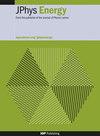利用相关显微镜和热量计了解新戊二醇塑料晶体中的热滞后变化
IF 6.3
3区 材料科学
Q1 ENERGY & FUELS
引用次数: 0
摘要
塑性晶体(PC)表现出固-固有序-无序的一阶相变,并伴随着大量相关的热量和体积变化。这些特性使 PC 成为加热和冷却应用中很有前途的热固性工作体。然而,要想让 PC 材料取代传统的气态制冷剂,了解 PC 在循环过程中转变温度和热滞后的变化至关重要。在这里,我们将扫描电子显微镜观察到的原型巴氏聚碳酸酯新戊二醇(NPG)的微观结构与红外成像和量热仪观察到的相变时的局部和整体热变化进行了关联。我们概述了 NPG 在反复热循环过程中通过固-固相变进行再结晶时的微观结构演变。观察到的微观结构变化与空间不均匀传热相关,从而直接了解了相变的动力学过程。我们的研究结果表明,这些过程的相互作用会影响不良热滞后以及有序相与无序相循环过程中稳定的动力学稳态微结构的性质。这些观察结果对于将 NPG 和其他 PC 用作技术上相关的巴焦材料具有重要意义,并提出了改变这些类型材料中滞后现象的方法。本文章由计算机程序翻译,如有差异,请以英文原文为准。
Understanding variations of thermal hysteresis in barocaloric plastic crystal neopentyl glycol using correlative microscopy and calorimetry
Plastic crystals (PCs) exhibit solid–solid order-disorder first-order phase transitions that are accompanied by large correlated thermal and volume changes. These characteristics make PCs promising barocaloric solid-state working bodies for heating and cooling applications. However, understanding the variation of transition temperatures and thermal hysteresis in PCs with cycling is critical if these materials are to replace traditional gaseous refrigerants. Here, for the archetypal barocaloric PC neopentyl glycol (NPG), we correlate microstructure obtained from scanning electron microscopy with local and total thermal changes at the phase transition from infra-red imaging and calorimetry, respectively. We outline an evolution in microstructure as NPG recrystallises during repeated thermal cycling through its solid–solid phase transition. The observed microstructural changes are correlated with spatially inhomogeneous heat transfer, yielding direct insight into the kinetics of the phase transition. Our results suggest that the interplay of these processes affects the undesirable thermal hysteresis and the nature of the kinetic steady-state microstructures that are stabilised during cycling between the ordered and disordered phases. These observations have implications for using NPG and other PCs as technologically relevant barocaloric materials and suggest ways in which the hysteresis in these types of materials may be modified.
求助全文
通过发布文献求助,成功后即可免费获取论文全文。
去求助
来源期刊

Journal of Physics-Energy
Multiple-
CiteScore
10.90
自引率
1.40%
发文量
58
期刊介绍:
The Journal of Physics-Energy is an interdisciplinary and fully open-access publication dedicated to setting the agenda for the identification and dissemination of the most exciting and significant advancements in all realms of energy-related research. Committed to the principles of open science, JPhys Energy is designed to maximize the exchange of knowledge between both established and emerging communities, thereby fostering a collaborative and inclusive environment for the advancement of energy research.
 求助内容:
求助内容: 应助结果提醒方式:
应助结果提醒方式:


